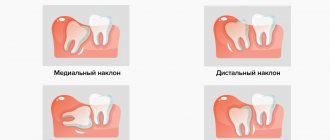Types of removal Causes of complications How long does the pain last What is the pain associated with?
Aching jaw Painful to swallow Throbbing pain How to relieve pain? Recommendations after removal Dental treatment can be therapeutic or surgical, and pain can occur after any type of intervention. If your wisdom tooth hurts after treatment, in most cases, this is a normal physiological reaction of the tissues to the procedure performed. Usually, painful sensations are quickly relieved with painkillers and go away on their own within a couple of days. But there are situations when pain after removal of the figure eight occurs due to complications or a violation of the technology of the therapeutic manipulation.
The dentist will definitely consult the patient about how the recovery process after the intervention should normally proceed, and if any symptoms appear, you should immediately consult a doctor. If all the doctor’s recommendations regarding the rehabilitation period are followed, but the painful sensations only increase, this is a direct indication to come for another appointment.
Types of deletion
Wisdom teeth (eights, third molars) are larger than other dental units in the row. They differ not only in size, but also in the complex anatomy of the root system. Eight has from 2 to 6 roots
, which are often closely intertwined with each other. Given the complex arrangement of wisdom teeth, when they are removed, a significant wound is created.
The risk of complications will directly depend on how difficult the figure eight extraction was. With simple extraction, when the tooth is intact, the roots are not intertwined, and there are no other pathologies (pulpitis, periodontitis, etc.), the risk of complications is minimal. In such a situation, the doctor uses forceps or an elevator to remove the tooth from the socket.
If the wisdom tooth is incorrectly positioned (horizontal eruption, severe curvature), intertwined roots, significant destruction of the coronal part, or the presence of inflammation, a more global surgical intervention may be required. An incision in the gum, cutting a tooth into pieces with a drill, removing root fragments through the jaw bone and other manipulations significantly increase the traumatic nature of the procedure. Aching pain, swelling after removal of the figure eight, increased temperature (up to 37.5℃), hematoma on the cheek - this is a normal reaction to the intervention, which lasts no more than 5-7 days.
Clinical manifestations of alveolitis
On the first day after tooth extraction, the hole hurts in all patients. However, the pain is not constant; within 24 hours it subsides and gradually disappears. If an infection penetrates the wound, after a few days the patient will begin to feel severe, hot, throbbing pain. Every day the painful sensations intensify - to the point of being unbearable.
If the inflammation is not very severe, the pain can be moderate; in severe cases, it spreads to the entire half of the face.
The patient's body temperature rises to 38 degrees. Healthy teeth react painfully to cold or hot food. In some cases, the lymph nodes become enlarged, and a putrid odor is felt from the mouth.
The patient refuses to eat, feels weak and unwell. He produces saliva intensively. If a massive tooth is removed and a large hole is formed, swelling of the face may occur. Sometimes erosions spread along the oral mucosa - these are secondary foci of infection.
The socket becomes loose and the gums become insensitive, but it will respond to pressure with acute pain.
Why complications arise
After extraction, a wound is left in the gum and bone in which a blood clot (fibrin) forms. It “seals” the wound, preventing infection, and becomes the basis for the formation of new tissue that fills the space formed after the removal of the 8. After uncomplicated removal, healing lasts about a week. On days 3-4, the blood clot is gradually replaced by granulation tissue, which gradually fills the entire socket. Already after a month, the granulation tissue is completely replaced by connective tissue, and after 3 months - by bone.
Removal of third molars can have negative consequences that appear almost immediately after the intervention. Among the most common complications:
- “dry socket” - when a blood clot does not form or dissolves too quickly;
- paresthesia - damage to the nerve endings around the removed unit;
- alveolitis - inflammation of the socket;
- bleeding;
- cyst - fibrous formation at the site of an extracted tooth;
- endogenous periostitis (flux).
In rare cases, stomatitis, osteomyelitis, jaw trauma, and perforation of the bottom of the maxillary sinus are observed. The occurrence of complications is usually associated with ignoring the dentist’s recommendations regarding oral hygiene during the healing period, decreased immunity, and violation of surgical technique.
Diagnosis of alveolitis
The main sign of pathology is pain, which returned 3-5 days after tooth extraction. Upon examination, the dentist will find that the wound in the socket has not healed. As a rule, this data is enough to establish a diagnosis and begin treatment.
In the case of chronic alveolitis, the dentist will notice an empty, unhealed hole in the place of a tooth that has long been removed. Normally, such a hole should be covered with granulation tissue.
Additional diagnostic methods:
- radiography;
- radiovisiography (digital radiography).
Pain after wisdom tooth removal
Patients are always interested in the question, how many days does the jaw hurt after wisdom tooth removal? Pain after surgery is a standard tissue response to injury. Normally, the pain subsides within a few hours or within 3 days after extraction (in case of complicated removal). The pain a patient experiences after wisdom tooth removal indicates the success of the procedure.
- The first discomfort and pain appear 2-3 hours
after the intervention (when the anesthetic wears off). - The first 3-4 days
there is aching pain, redness and swelling of the soft tissues. If the extraction is successful and the hole is properly cared for, the pain will gradually disappear. - Over the next 2 weeks
, if there are no complications, the wound will heal completely, and minor pain may occasionally occur in the late afternoon. - After 3 weeks,
all discomfort should disappear.
If a wisdom tooth has been pulled out and it hurts for more than 5 days, the intensity of the pain increases, it becomes throbbing, debilitating, accompanied by fever, swelling - this indicates a complication and requires immediate medical intervention.
General information
Normally, after tooth extraction, a fibrin frame—a white protective film—appears in the socket within 3 days. And after a week, the hole is overgrown with epithelium.
If this does not happen, a so-called dry socket forms.
There are two forms of alveolitis in the tooth socket:
- acute, when pain appears 3 days after tooth extraction;
- chronic, if the pain returns later. In this case, suppuration occurs, which quickly increases in size.
Due to hormonal characteristics, alveolitis develops more often in women. Patients over 40 years of age are also at risk; with age, the blood supply to the gums deteriorates, which complicates the healing of the socket. People who smoke are more likely than others to suffer from complications after tooth extraction; nicotine impedes blood circulation in the gums. The removal of third molars—wisdom teeth—is especially traumatic, as it often leads to injury to the tissue and bone of the jaw.
+7
Select time
What could be causing the pain?
If the pain after removing the figure eight does not subside within 5-7 days, but rather intensifies, this may indicate the following complication:
- Alveolitis
is an inflammation of the socket associated with the absence of a blood clot, poor hygiene, infection of the wound, or the presence of a bone fragment in the socket (if the tooth was extracted in parts). - Severe damage to the blood vessels
of the surrounding tissues - in addition to pain, there is a hematoma, swelling of the gums and cheeks. - Allergy
to anesthetic, hemostatic sponge (if it was used during the procedure).
As inflammation develops, pain is accompanied by an unpleasant odor, purulent discharge from the socket, the formation of gray plaque, enlarged lymph nodes, increased temperature, and deterioration in general well-being. In this case, you need to see a doctor immediately.
Aching jaw
When the jaw hurts after wisdom tooth removal, it is usually due to the fact that the surgeon put pressure on it to gain access to the molar. Or during the procedure, blood vessels, nerve endings, and ligaments of adjacent dental units were injured. These symptoms are quite normal, if there is no difficulty opening the mouth, there is no pronounced swelling of the gums or soft tissues of the face.
It hurts to swallow
After extraction of the lower 8, you may experience a sore throat or pain when swallowing. This symptom appears against the background of severe damage to soft tissues, with severe swelling of the gums, cheeks, or due to trauma to the trigeminal nerve. If the trigeminal nerve was affected during the operation, there is not only pain, which can radiate to the temple, ear, neck, but numbness on the face, in the area of the removed unit, and increased salivation. Also, a sore throat may occur if there is inflammation or purulent process around the affected molar. This symptom can last up to 2 weeks. To avoid complications, you should visit a neurologist or dentist.
Throbbing pain
If your gums ache after wisdom tooth removal, but the discomfort is quickly relieved with an analgesic and disappears after 2-3 days, this is evidence of normal healing. On the contrary, throbbing pain in the jaw or gums indicates possible inflammation, damage to blood vessels and nerves. With neuritis (damage to the jaw nerves), it can radiate to the neck, throat, temple, ear, eye. The pain increases, prevents you from falling asleep, and interferes with normal life - in this case, you need to immediately consult a dentist, this is a sign of inflammation.
Symptoms of alveolitis
The patient should be wary if, three days after tooth extraction, he discovers the following signs:
- Aching pain radiates to the ear, temple, and back of the head. The pain may be intermittent, but when you move your jaw (for example, when chewing), it returns. Painkillers help for a short time.
- The temperature rises to 38 degrees.
- There is an unpleasant odor coming from the hole.
- The cheek is swollen.
- When examined in a mirror, a yellowish or gray coating, pieces of food or empty space are visible in the hole.
If you are not sure that you have alveolitis of the socket, but have discovered some of the listed signs, do not try to get rid of the problem yourself. Contact your dentist, he will determine whether normal healing is taking place after a complex removal or whether alveolitis is developing.
How to relieve pain and discomfort
- Do not touch the blood clot in the socket with your tongue, toothbrush, hands or foreign objects;
- make oral baths from herbal decoctions and antiseptic solutions;
- if the pain radiates to the ear or another part of the head, take a painkiller;
- exclude hot food and drinks.
If your gums hurt for several days after wisdom tooth removal or you have a headache, you don’t need to worry too much. Analgesics prescribed by your dentist will help you cope with these symptoms. If the discomfort does not go away after a week, painkillers do not help much - you need to go to the doctor. If the temperature is above 37.5℃, which does not decrease to normal, the development of an allergic reaction (to an analgesic, hemostatic sponge), or a sharp deterioration in health, you should consult a doctor immediately.
Causes of alveolitis
After a tooth is removed, the bottom of the socket is covered with a dense clot of coagulated blood. In this case, the wound heals within a few days, and intense pain goes away within a day.
If the clot is dislodged for any reason or does not form at all, the wound remains open and represents a gateway for infection. Pathogenic microorganisms and food debris are constantly present in the mouth, which can settle in an open wound. Alveolitis occurs, the hole becomes inflamed and does not heal for a long time.
Causes of inflammation of the socket:
- Violation by the patient of the regimen that the doctor recommended to follow after tooth extraction. Including: physical activity, aggressive rinsing with medicinal solutions.
- Lack of oral hygiene or excessive brushing. This may cause the clot to dislodge.
- Food particles getting into the hole.
- Caries of adjacent teeth, stomatitis, inflammatory processes. That is why, in the absence of emergency indications, dentists first treat diseased teeth, and only then remove those that can no longer be restored.
- Incorrect treatment of the hole by a doctor or incomplete removal of tooth fragments and granulomas at its root.
- Complicated procedure. Alveolitis can occur after the removal of a wisdom tooth or supernumerary teeth. In this case, the angle of inclination and the size of the roots can lead to the formation of a large hole in which it is difficult for the protective clot to stay.
Prevention of alveolitis
To prevent a blood clot from forming in the socket and preventing infection, follow these recommendations:
- do not rush to remove the tampon immediately after tooth extraction. Heavy bleeding may flush out the clot;
- do not eat for 2-3 hours after the manipulation, avoid hard, spicy and hot foods;
- do not go to the bathhouse, do not play sports;
- do not rinse your mouth too vigorously;
- do not remove stitches yourself;
- do not self-medicate. Any procedures at the site of the extracted tooth must be prescribed by a doctor.










